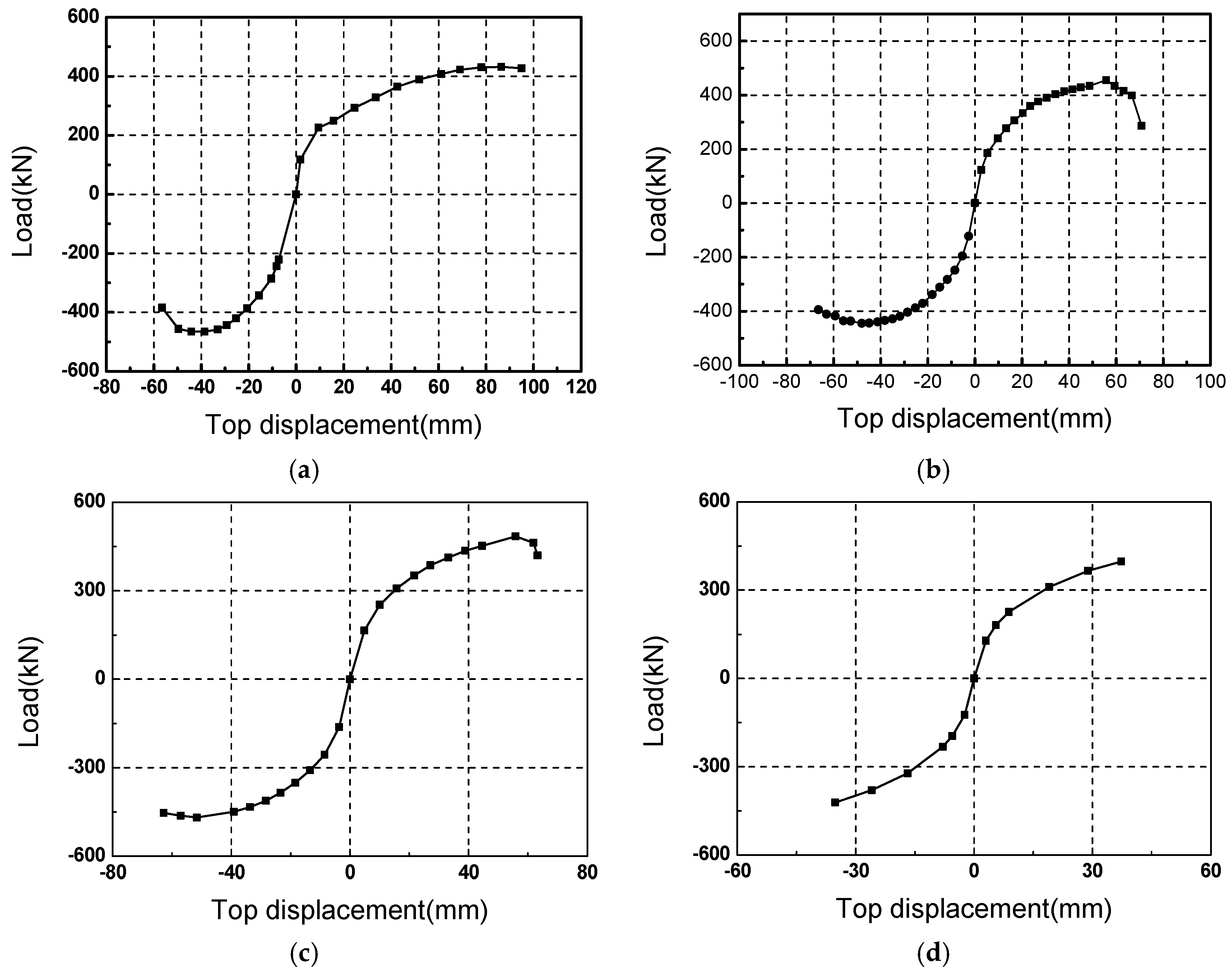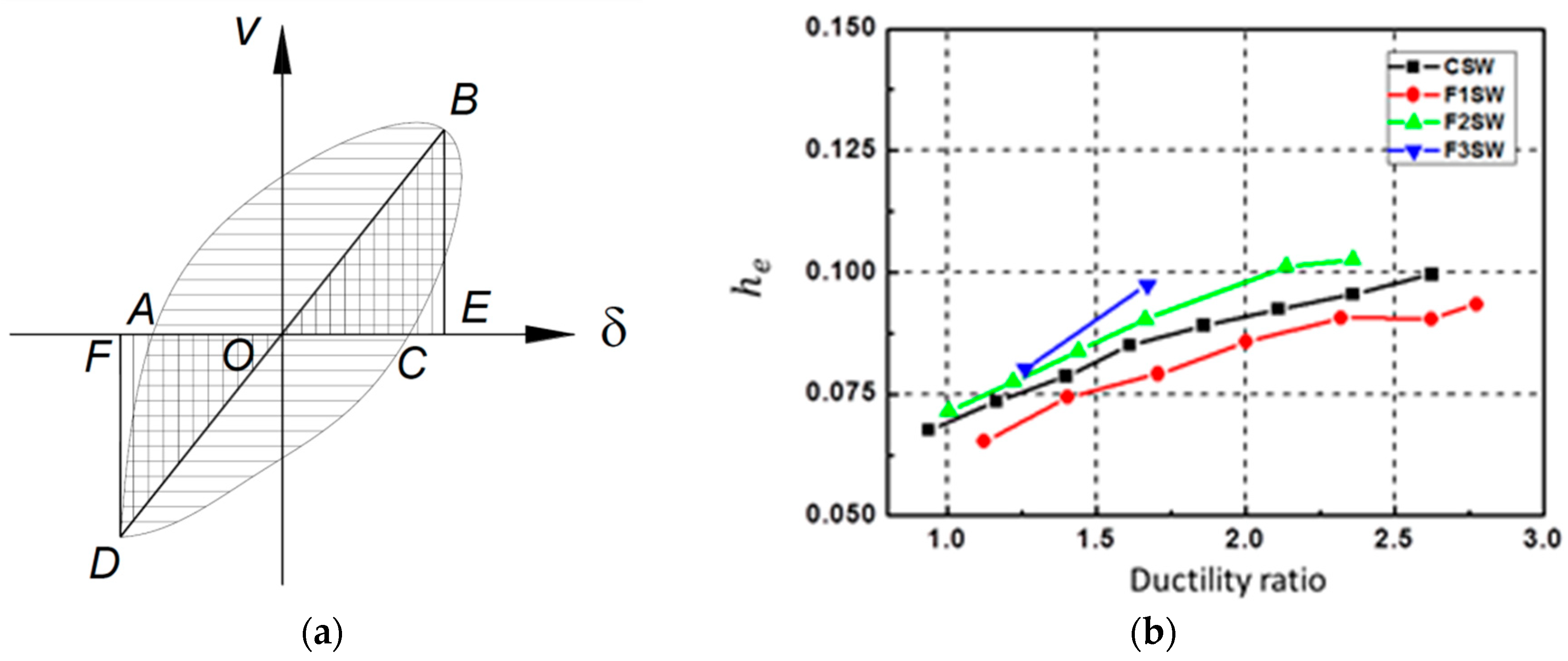Experimental Study and Numerical Simulation on Hybrid Coupled Shear Wall with Replaceable Coupling Beams
Abstract
:1. Introduction
2. Experimental Setup and Instrumentation
2.1. Experimental Specimens
2.2. Experimental Setup
3. Experimental Results and Discussion
3.1. Experimental Observations
3.1.1. Failure Mode of Coupling Beams
3.1.2. Failure Mode of Wall-Piers
3.2. Hysteretic Curve and Skeleton Curve
3.3. Strength Degradation and Stiffness Degradation
3.4. Energy Dissipation Capacity
3.5. Strain Analysis
3.6. Discussions and Suggestions
4. Finite Element Implementation
4.1. Modeling Method
4.2. Simulated Deformation
4.3. Yield Sequence
4.4. Concrete Damage Analysis
4.5. Skeleton Curve
5. Conclusions
- (1)
- Although the three fuses are different in working mechanism, the three HSWs exhibit similar global seismic performance. Under cyclic lateral forces, the plastic deformations of conventional coupling beams are concentrated at the beam ends, which are also the most vulnerable to damage. As for the three HSWs, the deformations of the beams are concentrated at the “fuses”, which can be easily replaced. The wall foots of CSW are severely crushed while those of HSWs are not.
- (2)
- It is proved that HSWs meet the design requirements as CSW, with many desirable properties. The strength, ductility, energy dissipation capacity, and stiffness degradation rules of HSWs are similar to those of CSW. At the same time, the load retention capacity of HSWs are also close or even better than that of CSW.
- (3)
- Strain analysis shows that the plastic area of the wall-piers of CSW extends to the second floor, causing widespread damage. As for HSW, the plastic area is only within the first floor. At the same time, the embedded steel, and longitudinal steel bars of the non-yield sections are far from yielding.
- (4)
- The deformation, yield sequence, hysteretic behavior, and damage distribution of HSWs can be well simulated in ABAQUS software. In addition, nonlinear finite element analysis proves that HSWs have ideal yield sequence that the “fuses” yield earlier than the wall foots. More importantly, numerical simulation verifies that the damage of the RCBs is concentrated at the “fuses” and the concrete damage of HSWs is visibly alleviated.
- (5)
- Among the three HSWs, F1SW is better in ductility and load retention ability, while F2SW is better in energy consumption. In general, both F1SW and F2SW have good application prospects, with desirable seismic properties. The cracks of Fuse 1 and 2 first appear at the place where the stress is concentrated. If the stress concentration can be alleviated by optimizing the opening angle and improving the welding quality, the anti-cracking capacity of Fuse 1 and 2 may be improved. As for F3SW, despite the out-of-plane buckling, it still has ideal failure mode and good seismic performance. In the further research, improvements such as adding longitudinal stiffeners at the fuse should be taken to prevent out-of-plane buckling. In the authors’ opinion, F1SW is the easiest one to be designed and fabricated in engineering applications because the configuration of Fuse 1 is relatively simpler, hence engineers can easily simulate its mechanical behavior and further obtain the practical design methods. Compared to Fuse 1, the configurations of Fuse 2 and 3 are more complicated. The interaction mechanism between lead core and steel plate is complicated, which will need more works to solve it.
Author Contributions
Funding
Conflicts of Interest
References
- Ang, H.S. Seismic Damage Analysis of Reinforced Concrete Buildings. J. Struct. Eng. 1985, 111, 740–757. [Google Scholar]
- Takeda, T. Reinforced Concrete response to simulated earthquakes. J. Struct. Div. Proc. Am. Soc. Civil Eng. 1970, 96, 2557–2573. [Google Scholar]
- Lu, Z.; Chen, X.; Lu, X.; Yang, Z. Shaking table test and numerical simulation of an RC frame-core tube structure for earthquake-induced collapse. Earthq. Eng. Struct. Dyn. 2016, 45, 1537–1556. [Google Scholar] [CrossRef]
- El-Tawil, S.; Kuenzli, C.; Hassan, M.; Kunnath, S. Inelastic Behavior of Hybrid Coupled Walls. J. Struct. Eng. 2004, 130, 285–296. [Google Scholar]
- Aristizabal-Ocfaoa, J.D. Seismic Behavior of Slender Coupled Wall Systems. J. Struct. Eng. 1987, 113, 2221–2234. [Google Scholar] [CrossRef]
- Paulay, T. Coupling Beams of Reinforced Concrete Shear Walls. J. Struct. Div. 1971, 97, 843–862. [Google Scholar]
- Hindi, R.A.; Hassan, M.A. Shear capacity of diagonally reinforced coupling beams. Eng. Struct. 2004, 26, 1437–1446. [Google Scholar] [CrossRef]
- Galano, L.; Vignoli, A. Seismic behavior of short coupling beams with different reinforcement layouts. Struct. J. 2000, 97, 876–885. [Google Scholar]
- Ding, D.; Cao, Z.; Zhang, S. Experimental studies of new ductile coupling beams and multi-storey shear walls. Mater. Struct. 1997, 30, 566–573. [Google Scholar]
- Parramontesinos, G.J.; Canbolat, B.A. Experimental Study on Seismic Behavior of High-Performance Fiber-Reinforced Cement Composite Coupling Beams. Struct. J. 2005, 102, 159–166. [Google Scholar]
- Lu, X.; Mao, Y.; Chen, Y.; Liu, J.; Zhou, Y. New structural system for earthquake resilient design. J. Earthq. Tsunami 2013, 7, 1350013. [Google Scholar] [CrossRef]
- Vargas, R.; Bruneau, M. Experimental Response of Buildings Designed with Metallic Structural Fuses. II. J. Struct. Eng. 2009, 135, 394–403. [Google Scholar] [CrossRef]
- Vargas, R.; Bruneau, M. Analytical Response and Design of Buildings with Metallic Structural Fuses. I. J. Struct. Eng. 2009, 135, 386–393. [Google Scholar] [CrossRef]
- Fortney, P.J.; Shahrooz, B.M.; Rassati, G.A. Large-Scale Testing of a Replaceable “Fuse” Steel Coupling Beam. J. Struct. Eng. 2007, 133, 1801–1807. [Google Scholar] [CrossRef]
- Li, X.; Lv, H.L.; Zhang, G.C.; Ding, B.-D. Seismic behavior of replaceable steel truss coupling beams with buckling restrained webs. J. Constr. Steel Res. 2015, 104, 167–176. [Google Scholar] [CrossRef]
- Ji, X.; Liu, D.; Sun, Y.; Hutt, C.M. Cyclic Behavior of Replaceable Steel Coupling Beams. Earthq. Eng. Struct. Dyn. 2017, 46, 517–535. [Google Scholar] [CrossRef]
- Wang, L.; Mao, C.; Dong, J. Seismic performance of shear wall structure with shape memory alloy dampers in coupling beams. World Earthq. Eng. 2011, 27, 101–107. [Google Scholar]
- Kurama, Y.C.; Shen, Q. Posttensioned Hybrid Coupled Walls under Lateral Loads. J. Struct. Eng. 2004, 130, 297–309. [Google Scholar] [CrossRef]
- Kurama, Y.C.; Shen, Q. Nonlinear Behavior of Posttensioned Hybrid Coupled Wall Subassemblages. J. Struct. Eng. 2002, 128, 1290–1300. [Google Scholar]
- Ji, X.; Liu, D.; Sun, Y.; Hutt, C.M. Seismic performance assessment of a hybrid coupled wall system with replaceable steel coupling beams versus traditional RC coupling beams. Earthq. Eng. Struct. Dyn. 2017, 46, 517–535. [Google Scholar] [CrossRef]
- Shahrooz, B.M.; Fortney, P.J.; Harries, K.A. Steel Coupling Beams with a Replaceable Fuse. J. Struct. Eng. 2018, 144, 04017210. [Google Scholar] [CrossRef]
- Lu, X.; Chen, Y.; Jiang, H. Earthquake resilience of reinforced concrete structural walls with replaceable “fuses”. J. Earthq. Eng. 2016, 22, 801–825. [Google Scholar] [CrossRef]
- Lu, X.; Jiang, H. Recent progress of seismic research on tall buildings in China Mainland. Earthq. Eng. Eng. Vib. 2014, 13, 47–61. [Google Scholar] [CrossRef]
- GB50011. Code for Seismic Design of Buildings in China; China Architecture & Building Press: Beijing, China, 2010.
- GB50010. Code for Design of Concrete Structures; China Architecture & Building Press: Beijing, China, 2015.
- Park, R.; Paulay, T. Reinforced Concrete Structures; John Wiley & Sons.: New York, NY, USA, 1975. [Google Scholar]
- Hibbit, Karlsson & Sorensen, Inc. ABAQUS User’s Manual; Hibbit, Karlsson & Sorensen, Inc.: Johnston, RI, USA, 2018. [Google Scholar]
- Håkansson, P.; Wallin, M.; Ristinmaa, M. Comparison of isotropic hardening and kinematic hardening in thermoplasticity. Int. J. Plast. 2005, 21, 1435–1460. [Google Scholar] [CrossRef]
- Lubliner, J.; Oliver, J.; Oller, S.; Oñate, E. A plastic-damage model for concrete. Int. J. Solids Struct. 1989, 25, 299–326. [Google Scholar] [CrossRef]
- Wight, J.K.; Macgregor, J.G. Reinforced Concrete-Mechanics and Design; Pearson Prentice Hall: Upper Saddle River, NJ, USA, 2009. [Google Scholar]
- Reinhardt, H.W.; Cornelissen, H.A.W. Post-peak cyclic behaviour of concrete in uniaxial tensile and alternating tensile and compressive loading. Cem. Concr. Res. 1984, 14, 263–270. [Google Scholar] [CrossRef]
- Zhang, J.; Wang, Q.; Hu, S. Parameters Verification of Concrete Damaged Plastic Model of ABAQUS. Build. Struct. 2008, 38, 127–130. [Google Scholar]



















| Design Shear Force | Design Bending Moment | |
|---|---|---|
| Conventional coupling beam | ||
| Replaceable coupling beam |
| Specimen | CSW | F1SW | F2SW | F3SW | ||||
|---|---|---|---|---|---|---|---|---|
| Loading direction (+: Positive; −: Negative) | + | − | + | − | + | − | + | − |
| Yield displacement (mm) | 34.07 | −24.73 | 26.36 | −20.97 | 28.57 | −22.41 | 20.30 | −23.70 |
| Yield load (kN) | 351.69 | −376.30 | 374.16 | −358.65 | 393.71 | −378.88 | 317.12 | −362.70 |
| Peak displacement (mm) | 73.75 | −55.10 | 55.75 | −48.06 | 55.84 | −51.63 | --- | −54.27 |
| Peak load (kN) | 431.46 | −463.82 | 455.06 | −444.27 | 484.04 | −468.54 | --- | −453.03 |
| Ultimate displacement (mm) | 81.80 | −77.43 | 67.29 | −66.46 | 63.27 | −62.80 | --- | −81.73 |
| Ultimate load (kN) | 426.74 | −388.99 | 386.80 | −393.71 | 419.32 | −453.03 | --- | −429.44 |
| Ductility ratio | 2.38 | 3.13 | 2.55 | 3.17 | 2.21 | 2.80 | --- | 3.45 |
| Steel Grade | Diameter (mm) | Yield Strength (MPa) | Ultimate Strength (Mpa) |
| HPB235 | 6 | 330 | 405 |
| HPB235 | 8 | 340 | 400 |
| HRB335 | 12 | 400 | 530 |
| HRB335 | 20 | 355 | 500 |
| Concrete Grade | Cubic Compressive Strength fcu (Mpa) | Elastic Modulus E (Mpa) | |
| C25 | 21.16 | 21375 | |
| 32 | 0.1 | 1.16 | 0.6667 | 0.003 |
© 2019 by the authors. Licensee MDPI, Basel, Switzerland. This article is an open access article distributed under the terms and conditions of the Creative Commons Attribution (CC BY) license (http://creativecommons.org/licenses/by/4.0/).
Share and Cite
Chen, Y.; Li, J.; Lu, Z. Experimental Study and Numerical Simulation on Hybrid Coupled Shear Wall with Replaceable Coupling Beams. Sustainability 2019, 11, 867. https://doi.org/10.3390/su11030867
Chen Y, Li J, Lu Z. Experimental Study and Numerical Simulation on Hybrid Coupled Shear Wall with Replaceable Coupling Beams. Sustainability. 2019; 11(3):867. https://doi.org/10.3390/su11030867
Chicago/Turabian StyleChen, Yun, Junzuo Li, and Zheng Lu. 2019. "Experimental Study and Numerical Simulation on Hybrid Coupled Shear Wall with Replaceable Coupling Beams" Sustainability 11, no. 3: 867. https://doi.org/10.3390/su11030867





